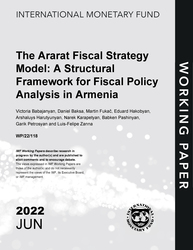
The Ararat Fiscal Strategy Model: A Structural Framework for Fiscal Policy Analysis in Armenia
The Ararat Fiscal Strategy Model: A Structural Framework for Fiscal Policy Analysis in Armenia
READ MORE...
Volume/Issue:
Volume 2022
Issue 118
Publication date: June 2022
ISBN: 9798400210754
$20.00
Add to Cart by clicking price of the language and format you'd like to purchase
Available Languages and Formats
| English |
Prices in red indicate formats that are not yet available but are forthcoming.
Topics covered in this book
This title contains information about the following subjects.
Click on a subject if you would like to see other titles with the same subjects.
Economics- Macroeconomics , Public Finance , Economics / General , Structural model , DSGE model , fiscal rules , scenario analysis , financial programming , Armenia , Covid-19 , AFSM simulation , shock decomposition , fiscal policy multiplier , AFSM application , overview of the Ararat Fiscal Strategy Model , Consumption , Public investment spending , Current spending , Global
Summary
This paper presents an overview of the Ararat Fiscal Strategy Model (AFSM), which is a structural, New-Keynesian, DSGE, small open economy model with a rich fiscal block that includes several expenditure and revenue instruments, and types of debt. The AFSM is now a formal part of the Ministry of Finance analytical toolkit to do macroeconomic fiscal policy scenario analysis, which feeds into policy discussions, budget planning, and the Medium-Term Expenditure Framework. The model was applied to assses the macroeconomic impact of the “first wave” of the Covid-19 pandemic on the Armenian economy, including the mitigating effects of policy responses. AFSM simulations revealed a potential severe impact in 2020, with declines in GDP and consumption of 12.9 and 11.7 percent, respectively, and a cumulative loss of GDP of 38 percent for the period 2020-2023. They also highlighted a significant fiscal outlook deterioration that would increase public debt-to-GDP ratios by 18.8 percentage points over 2020-23. The package of counter-cyclical fiscal measures of 3.6 percent of GDP, however, was estimated to cushion the 2020 GDP decline by almost 2 percentage points, as well as protect jobs. A second AFSM application related to the 2018 public investment under-execution showed the importance of improving the efficiency of public investment to have positive macroeconomic and fiscal effects.
Copyright © 2010 - 2025
Powered by:
AIDC



